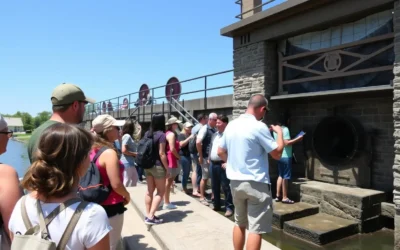✓ Accommodations✓ Flights✓ Rental Cars
As you explore the state of Illinois, you’ll find a rich tapestry of languages spoken throughout its communities. With a diverse population, the state’s linguistic landscape is shaped by various cultures.
According to census data, a significant percentage of the population speaks languages other than English at home. For instance, around 13.2% of the population speaks Spanish, followed by other languages like Polish, Chinese, and Tagalog.
This diversity is not limited to urban areas like Chicago; it’s also present in rural communities downstate. Understanding the languages spoken in Illinois is crucial for appreciating the state’s cultural richness and addressing the needs of its diverse population.
The Linguistic Landscape of Illinois
With a population of approximately 12.5 million people, Illinois presents a fascinating case of linguistic diversity. As the 6th most populous state in the United States, it is home to a significant number of residents from diverse racial and ethnic backgrounds.

Illinois at a Glance: Population and Diversity
Illinois’ demographic makeup is characterized by a rich tapestry of cultures. According to census data, over 20% of Illinois residents speak a language other than English at home, contributing to the state’s ranking as the 5th most linguistically diverse in the nation. The state’s diverse population is reflected in its urban centers, particularly in Chicago, one of America’s most diverse cities.
The total population of Illinois represents a broad spectrum of racial and ethnic groups. This diversity is a result of historical immigration patterns that have shaped the current language landscape, creating vibrant cultural enclaves throughout the state.
Why Language Diversity Matters in Illinois
Language diversity is crucial for social cohesion, economic opportunity, and cultural preservation across Illinois communities. The distribution of non-English languages across different population groups and geographic regions within the state highlights the importance of linguistic diversity.
In Illinois, the presence of numerous language communities supports a dynamic cultural environment. Understanding and embracing this diversity can foster greater inclusivity and economic growth, making it an essential aspect of the state’s social fabric.
Official Language Status in Illinois
In the United States, Illinois is notable for not having an official language enshrined in state law. Despite the absence of a legally designated official language, English is widely used in government operations, education, and business, effectively functioning as the de facto official language.
English as the De Facto Official Language
English is the predominant language used in official contexts, including government services, courts, and public education. This de facto status means that most official documents and government services are available primarily in English. As a result, individuals with limited English proficiency may face challenges accessing certain state services. Data shows that the lack of official language designation impacts various types of state services and the accessibility of information for non-English speakers.

Language Legislation History in Illinois
Throughout Illinois’ legislative history, there have been various attempts to establish English as the official language. These efforts reflect broader debates about language policy and cultural identity. The history of language legislation in Illinois includes both successful and failed bills, with ongoing debates reflecting cultural and political tensions. A review of the data related to language policy reveals the complexity of the issue and its impact on the state’s population.
| Aspect | Details | Impact |
|---|---|---|
| De Facto Language | English used in government, education, and business | Predominant language for official contexts |
| Legislative Attempts | Various bills to establish English as official language | Reflects cultural and political debates |
| Population Impact | Lack of official language designation affects non-English speakers | Challenges in accessing state services and information |
Illinois, United States: Official and widely spoken languages
As you explore the linguistic landscape of Illinois, you’ll discover a multitude of languages spoken by its residents. The state’s diverse population has led to a variety of languages being spoken at home.
Top 10 Languages Spoken in Illinois Homes
According to census data, the top languages spoken in Illinois homes are diverse, reflecting the state’s cultural melting pot. Spanish is the most widely spoken language at home, with 13.2% of the population (1.6 million speakers) using it.
The top 10 languages spoken in Illinois homes are:
| Language | Percentage of Population | Number of Speakers |
|---|---|---|
| Spanish | 13.2% | 1.6M |
| Polish | 1.5% | 180K |
| Chinese | 0.8% | 102K |
| Tagalog | 0.7% | 82K |
| Arabic | 0.5% | 62K |
| Other Indo-European languages | 0.4% | 47K |
| Urdu | 0.4% | 47K |
| Korean | 0.4% | 45K |
| Gujarati | 0.4% | 44K |
| Hindi | 0.3% | 42K |
Comparison with National Language Statistics
When comparing the language demographics of Illinois to national averages, some differences become apparent. For instance, Polish is significantly more prevalent in Illinois than in many other states, forming the second-largest language group at 1.5% (180,000 speakers).

The data also reveals interesting patterns about households where multiple languages are spoken, showing the percentage of multilingual families across different regions. Understanding these patterns can provide insights into the linguistic diversity and cultural influences within the state.
Spanish Language in Illinois
As you explore the linguistic landscape of Illinois, you’ll find that Spanish plays a significant role in the state’s cultural identity. The data reveals that Spanish is spoken by 13.2% of Illinois residents, which translates to approximately 1.6 million people.
Spanish-Speaking Demographics and Distribution
The Spanish-speaking population in Illinois is diverse, with heritage from Mexico, Puerto Rico, Guatemala, and other Latin American countries. You can see a significant concentration of Spanish speakers in cities like Chicago, Aurora, Elgin, Waukegan, and Cicero. In Chicago, neighborhoods such as Pilsen, Little Village, and Humboldt Park have notable Spanish-speaking communities.
About 41.2% of Spanish speakers in Illinois report speaking English less than “very well.” This data highlights the importance of language services and resources for the Spanish-speaking population.
| City | Spanish-Speaking Population | Percentage of Total Population |
|---|---|---|
| Chicago | 1,200,000 | 12% |
| Aurora | 120,000 | 20% |
| Elgin | 50,000 | 15% |
Spanish Language Services and Resources
The data shows that Spanish language services have evolved significantly in Illinois, with increasing availability in healthcare, education, and government settings. You can find various resources, including Spanish language media, such as radio stations, newspapers, and television channels, that cater to the Hispanic population.
Spanish-speaking households in Illinois contribute significantly to local economies and entrepreneurship. The presence of Spanish language services and resources has a positive impact on the community, enabling better access to information and opportunities.
European Languages in Illinois
Illinois’ linguistic diversity is significantly influenced by its European heritage. The state’s history of immigration has contributed to a rich tapestry of languages, with various European communities maintaining their linguistic traditions.

Polish Community and Language Presence
The Polish community in Illinois is one of the largest outside of Poland, with approximately 180,000 residents speaking Polish, which accounts for about 1.5% of the state’s population. This significant number is a testament to the historical migration patterns that have shaped the state’s cultural landscape. About 53% of Polish speakers report speaking English less than “very well,” highlighting the importance of language support services within the community.
German, French, and Italian Speakers
Other European languages have a notable presence in Illinois. German, for instance, was once widely spoken, with many schools and newspapers operating in German before World War I. Today, German is spoken by around 35,500 people, or 0.3% of the population. Similarly, Italian is spoken by approximately 31,800 residents, reflecting the state’s historical ties to Italian immigration. French, though less prevalent, still maintains a presence, particularly in certain cultural and educational contexts.
Other European Languages
Beyond Polish, German, French, and Italian, other European languages contribute to Illinois’ linguistic diversity. Russian is spoken by around 40,000 residents, while Greek is spoken by approximately 31,100 people. These communities, along with others, maintain their cultural heritage through language schools, cultural centers, and religious institutions, ensuring the continued vitality of their languages within the state.
Employment patterns have historically influenced the settlement of European language speakers, with many finding work in Illinois’ manufacturing, agriculture, and service industries. Over time, these communities have preserved their languages across generations, contributing to the state’s rich linguistic landscape.
Asian Languages in Illinois
You can discover the vibrant Asian language communities thriving in Illinois, contributing to the state’s cultural mosaic. The presence of these languages is a testament to the diverse population living in Illinois, with various languages spoken in homes and communities across the state.
Chinese, Korean, and Tagalog Communities
Data from linguistic studies reveals that Chinese is spoken by approximately 102,000 Illinois residents, making it the third most common non-English language spoken in the state. The Chinese community is particularly vibrant in Chicago’s Chinatown, where cultural and linguistic traditions are maintained across multiple generations. Korean is another significant language, spoken by about 45,000 people, primarily concentrated in Chicago’s Albany Park and the northern suburbs, supporting a thriving Korean business community and cultural institutions.
The Filipino community in Illinois is also substantial, with 82,000 Tagalog speakers representing one of the fastest-growing Asian language groups in the state. This community contributes significantly to various industries, including healthcare, education, and small business ownership.
South Asian Languages: Hindi, Urdu, and Gujarati
South Asian languages have established a strong presence in Illinois, with significant numbers of speakers. Gujarati is spoken by 44,000 people, Hindi by 42,000, and Urdu by 47,000, with these communities often clustered in specific suburban areas. These language groups contribute to the state’s cultural diversity and play a crucial role in various sectors, including technology, healthcare, and education.
The data highlights the importance of language diversity in Illinois, with a significant percentage of the population speaking languages other than English at home. Understanding and supporting these language communities is crucial for fostering inclusivity and ensuring that all residents have access to essential services and opportunities.
English Proficiency Among Non-Native Speakers
As you explore the linguistic landscape of Illinois, English proficiency among non-native speakers emerges as a critical factor. The state’s diverse population, with numerous languages spoken at home, presents a complex picture of language proficiency. Understanding this aspect is essential for addressing the needs of Illinois’ residents effectively.
English Proficiency Rates by Language Group
Data from the census reveals significant variations in English proficiency rates among different language groups in Illinois. For instance, 41.2% of Spanish speakers report speaking English less than “very well.” This percentage is even higher among Polish and Chinese speakers, at 53%, while Korean speakers stand at 47.6%, and Tagalog speakers at 28.4%. Overall, about 4.5% of Illinois’ total population has limited English proficiency.
These statistics highlight the diverse challenges faced by different language communities in Illinois. Factors such as time spent in the United States, age at immigration, household income, and access to educational resources significantly influence English proficiency rates.
Language Barriers and Access to Services
Language barriers can significantly impact access to essential services for residents with limited English proficiency. You might be concerned about how these barriers affect healthcare, education, legal assistance, and social services. The data shows that language barriers can limit opportunities and create challenges in daily life, including employment opportunities, income potential, and household financial management.
To address these challenges, various state agencies and service providers are implementing measures such as interpreter services, translated materials, and bilingual staff. These efforts aim to improve access to services and support for Illinois residents with limited English proficiency. By understanding the nuances of English proficiency among non-native speakers, you can better appreciate the complexities of language diversity in Illinois and the ongoing efforts to address the associated challenges.
Language Education and Resources in Illinois
As you explore the language education landscape in Illinois, you’ll discover a variety of initiatives aimed at supporting language learners. The state’s education system has been designed to cater to the linguistic diversity, offering multiple language education resources.
Bilingual Education Programs
Illinois public schools offer various bilingual education programs, with over 200,000 English language learners enrolled statewide. The Illinois State Board of Education requires schools to provide bilingual education when 20 or more students speaking the same language are enrolled. For instance, Chicago Public Schools offers dual language programs in Spanish, Chinese, Arabic, and Polish.
Language Learning Resources
The data reveals how language learning resources vary by geographic region, with a greater concentration in areas with higher linguistic diversity. You can find resources tailored to different age groups and income levels, ensuring that language education is accessible to a broad population.
Translation and Interpretation Services
Various industries in Illinois have developed specialized translation and interpretation services to meet the needs of diverse language communities. Technology has also transformed language learning and access to translation services, making resources more accessible across different age groups and income levels.
| Language | Number of Speakers | Resources Available |
|---|---|---|
| Spanish | 1,000,000+ | Bilingual programs, translation services |
| Chinese | 200,000+ | Dual language programs, interpretation services |
| Polish | 100,000+ | Bilingual education, translation services |
Conclusion: The Future of Language Diversity in Illinois
Illinois’ diverse linguistic heritage is not just a reflection of its past but a driving force behind its future economic and cultural endeavors. As the state’s population continues to grow, demographic projections suggest a 10% increase in non-English speaking populations over the next decade, with significant growth in Spanish, Asian, and Middle Eastern language communities.
You’ll see how this growth will impact the distribution of languages across different regions of Illinois, with various industries and businesses adapting to serve the needs of multilingual consumers. The economic impact of language diversity will be significant, with multilingualism becoming increasingly valuable in various industry sectors.
The intersection of race, ethnicity, and language will continue to shape Illinois’ cultural identity, with technology and global connectivity transforming language learning and preservation efforts. As the state moves forward, it’s essential to prioritize language rights and access to information to ensure an inclusive society that values its diverse linguistic heritage.
The above is subject to change.
Check back often to TRAVEL.COM for the latest travel tips and deals.






